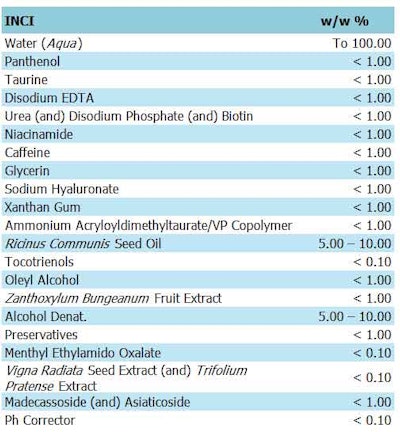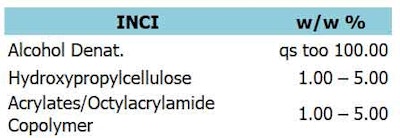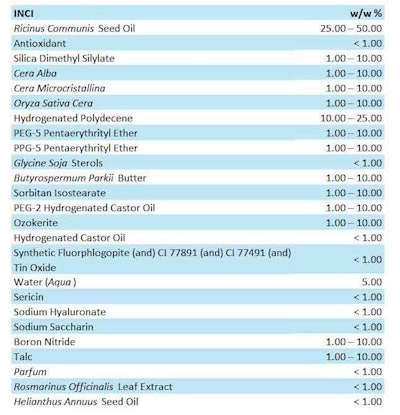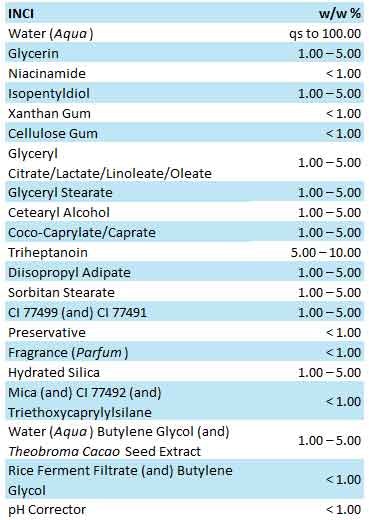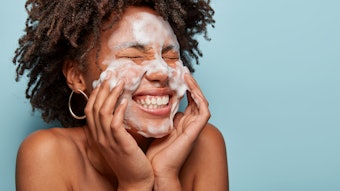
Between 1800 and 1900, color cosmetic companies were founded and began manufacturing these products industrially. However, color cosmetics became associated with danger. In 1869, for example, the American Medical Association published a paper on three cases of lead palsy that were attributed to the use of a whitening cosmetic containing lead acetate and carbonate. Reported symptoms included fatigue, weight loss, nausea, headaches, muscle atrophy and paralysis.1 Ironically, the eighteenth-century socialites became depicted as vain, silly women who were poisoned by their white lead makeup.2, 3 Responding to this and many other adverse events attributed to cosmetics, government institutions around the world took on the role of identifying which types of dyes could be used in cosmetics, to control and certify their purity and safety – a role these institutions still hold today.
Fifteen years after the end of World War II, in the 1960s, markets for other cosmetic product types rapidly developed; e.g., bubble baths, tooth whitening products and underarm deodorants. Makeup products also experienced an unexpected boom but their use profile changed dramatically. Initially used for special events, makeup in a way represented a symbol of extreme luxury, sex attraction and spending capability. Under the new dynamic, makeup was used more freely and frequently, becoming a daily companion in the average woman’s life.4
In the 50+ years following, color cosmetic products have continued to evolve. Mascara changed from being a rigid, cast product that the user would rub with water and apply to the lashes using an applicator, to a light, soft emulsion, easily distributed over the lashes and suitable for daily wear.5 Shiny lipsticks were adored, then shades shifted toward the world of pearls.
Initially, in the 1960s, only bismuth oxychloride was available for decorative cosmetics (forgetting fish pearl, which was only suitable for varnish) but in the 1970s, white and yellow titanium dioxide-on-mica pearls appeared. This was followed by an army of colored metallic, bronzed, gem-tone, velvety, silky, sparkling, small, medium and large, transparent or covering particles – all the sons of the marriage between mica and a vacuum deposited, thin layer of titanium dioxide.
Besides traditional sensory and application performance, decorative cosmetics have more recently been modified to meet consumer demand for longer wear and added benefits such as balancing hydration, providing skin protection, and fighting signs of aging or skin imperfections. Marketing claims for these products include the skinification of makeup products or make-care; i.e., a mix between skin care and makeup.
This article explores the latest iterations of color cosmetics including mascara and lash treatments; lipsticks, gels and balms; and foundations. It examines traditional and newer ingredients and describes their functions and utility to meet the needs of modern makeup.
Mascara
Long-lasting mascaras are usually among the best sellers on the market. They must be easy to apply, comfortable to wear, smudge-resistant and, above all, waterproof – in addition to imparting volume and the desired color.6
In 2003, a two-phase product was invented including a transparent coating plus a treatment for volume and brilliance effects.7 But even more revolutionary was the appearance of coated pigments in the 1980s. These resolved the problem of wetting the polar metallic surfaces (ionic oxides) by a scarcely polar vehicle that, on the other hand, was needed for waxes to be easily swollen. Pigment coatings reduced the catalytic pro-oxidation effect of iron oxides, improving product shelf-life while equalizing pigment surfaces. This transformed them into more compatible systems, making them more easily wetted by the vehicle.
Today, booming health care concerns have entered the makeup world, extending even to the eyelashes. Attempts have continually been made to strengthen the lash structure using specific active ingredients introduced into the mascara formula. A recent patent describes promising new active ingredients and a method of application to help promote lash growth.8
More specifically, the treatment outlined consists of three products that are successively applied and utilizes an ingredient in the patent mentioned above:8
- Eyelash strengthening gel-cream, to be applied to the base of the eyelashes;
- Lengthening and volumizing colored gel, to be applied on the eyelashes; and
- A filming and fixing alcohol gel, also to be applied to the eyelashes.
The first step of this treatment involves applying a formulation to provide nourishing properties for the hair bulb and stimulate the growth of the eyelashes; Formula 1 (see below) provides an example. This is a water-based gel into which a small quantity of castor oil – a mixture of triglycerides containing up to 90% ricinoleic acid and oleic (3%) and linoleic acids (3-4%) – is emulsified. This oil has a strong affinity for keratin and represents a good strengthening and restructuring agent. It is also a hydrating emollient.
The gel-cream is enriched with numerous active ingredients, such as a concentrated extract of mung bean and red clover, rich in polyphenols capable of stimulating the growth of eyelashes. Caffeine, by efficiently stimulating microcirculation, can promote the lengthening of the eyelashes. Centella asiatica extract, titrated in the heterosides madecassoside, terminoloside and asiaticoside, purportedly increases hair tensile strength by 125%. It also can ensure excellent anchoring of the hair shaft thanks to the stimulation of laminine-5 synthesis. The product is applied using a brush and the drying speed is quite fast, imparting a feeling of freshness and "immediate action."
The second step of the treatment involves the application of a black pigmented gel directly onto the eyelashes. This creates a film and defines them, giving a lengthening and volumizing effect. The product is applied with a brush like mascara and dries within minutes after application. Formula 2 (see below) provides an example.
The third step involves the application of an alcoholic gel that allows for good fixation and resistance to water and tears (see Formula 3, below). The product contains a thickening polymer and an acrylic resin capable of offering notable hold and filming effects and, at the same time, flexibility and adhesion to the eyelashes. The gel is applied with a brush and dries quickly. The fixing effect is long-lasting and persistent even after contact with water.
Lip Color
One of the disadvantages consumers point out about conventional lip products is the deterioration of their fresh appearance in a short period of time. To solve this problem and extend the wear properties of products, one of the most efficient techniques has been to use a film-forming polymer and waxes in combination with volatile oils that evaporate after contact with the lips. This imparts a no-transfer effect. However, the incorporation of the volatile oil into the lipstick composition reduces its glossy appearance over time and comfort on the lips. The formulation of a very glossy lipstick is different from classic products and no-transfer products because the level of the wax phase goes up to about 80%.
In lipsticks, surface-treated silica can be used as an oil gelling and structuring agent. Silica limits exudation or syneresis while providing a long-lasting matte finish look in long-wear lipsticks. For waxy/solid lipsticks, formulating with silica helps to enhance product transfer, especially in highly pigmented formulations. It also enhances storage and temperature stability.
In a previously described study, a lipstick base formula was prepared with glyceryl isostearate, trimethyl pentaphenyl trisiloxane and glycerol, and the characteristics and efficacy of the formula were investigated. The resulting single application-type lipstick demonstrated transfer-resistance properties and adequate moisturizing capability while imparting high luster to lips.9
Lips age faster than any other facial skin area, becoming thinner and flatter as they lose volume and elasticity over time.10 However, the combination of treatment and color is not always possible and often a difficult task – makeup products are anhydrous and active ingredients must be solved in order to be easily and efficiently delivered to the skin. The solution could be the selection of proper oily ingredients able to treat the lips, or the development of a water-in-oil gel structure that could be used to deliver hydrophilic ingredients. Formula 4 (see below) provides an example is a pearly lipo-gel that combines the brilliance of a lip gloss with the comfort of a lip balm.
This formula is based on a calibrated combination of liquid and semi-solid lipids:
- Octyldodecanol promotes the smoothness of the product on the lips;
- Octyldodecyl stearoyl stearate and diisostearyl malate give plumpness and shine;
- Shea butter provides emollient, softening and hydrating effects; and
- Bis-diglyceryl polyacyladipate is a green substitute for lanolin with the ability to bind considerable quantities of water with a film-forming, non-occlusive effect.
This gel is structured by a lipophilic viscosifier with a shiny and slightly sticky effect (ethylcellulose), and by a pair of waxes that favor the plastic and adhesive effect on the lips (synthetic wax and Oryza sativa bran wax). Adhesion to the lips and film formation are improved by the presence of the plant-based polymer derived from soybean, which also has a long-wear and shine-increasing effects. The formula also contains an olive leaf extract, clinically tested to preserve the skin barrier function, preventing dehydration.
In a similar formula (see Formula 5, below), the addition of a w/o emulsifier enables the introduction of 5% water as the right vehicle for two powerful hydrating polymers: sericin and sodium hyaluronate.
Foundation
Foundations are, in most cases, oil-in-water, water-in-oil or water-in-silicone emulsions. They are characterized by the presence of pigments and fillers, whose equilibrium and amount decides their covering power or transparency. Pigments are inorganic and cannot be absorbed by the skin.
Sebum and sweat are typically the worst enemies of long-lasting color cosmetics, especially in emulsion foundations or loose and pressed anhydrous powders. The typical consumer expects a perfectly matched shade and a non-transferable, matte and uniform appearance throughout the life of a long-wear foundation. Such products must last at least 8-10 hours per day, have a variety of shades, be easy to apply and provide a variety of skin finishes.
To achieve these properties, the formulation chemist must choose materials that impart such performance: the film-formers. Often, these films can be plasticized and delaminated by sweat and sebum, making the adhesion very weak and facilitating the transfer onto other surfaces such as textile clothing or other body parts.11, 12 This effect could be reduced or eliminated by using appropriate fillers to absorb the sebum and extend product longevity.13
The most traditional fillers in foundations include hydrophilic kaolin, which provides water absorption and skin adhesion, and lipophilic talc, used for its transparency and slipperiness. But the classic foundation is no longer desired – consumers today want unique treatments that ideally combine the properties of a serum, moisturizer, base cream, foundation and sunscreen. Pigmented creams like BB, CC, DD, etc., are preferred, which vary in coverage, color and finish (matte, natural or dewy), and unlike makeup foundations that focus solely on color and coverage, they go a step further with added skin care benefits.
The example in Formula 6 (see below)is an oil-in-water emulsion based on an anionic emulsifier of vegetal origin combined with two hydrophilic gelling agents made of xanthan gum and sodium carboxy methylcellulose, which give the product a comfortable, soft and velvety sensation on the skin. The presence of emollient esters with a light and non-greasy touch, such as coco-caprylate/caprate, triheptanoin or diisopropyl adipate, contribute to a dry sensation while ensuring good spreadability of the makeup base over the entire face. The humectant and hydrating effects are supported by glycerin and isopentyldiol. The presence of small percentages of pigments plus some pearls makes the complexion uniform and luminous, ready to receive makeup or stand alone for a nude look.
The smoothing and soft-focus effect is obtained thanks to spherical eco-friendly silica particles that provide a matte effect. The formula is enriched by active ingredients including:
- A biofunctional cocoa bean extract that acts as a shield for the skin against blue light pollution;
- A fermented rice extract with hydrating, smoothing and illuminating actions; and
- Niacinamide and vitamin B3, which stimulate the synthesis of collagen and elastin, reduce pigmented spots, illuminate skin and normalize sebum.
Conclusion
Over the past two years, the cosmetics industry has faced unprecedented challenges driven by social media, changing consumer perceptions and needs, and more restrictive regulations. For example, in Europe the use of low molecular weight cyclic silicones is nearly prohibited, much like microplastics (solid polymer particles), which have always been used as soft-touch particles and for optical effects, e.g., a long-lasting matte appearance. For more on this, see Hollenberg.
Likewise, consumers are looking for ideal products for long-lasting lip or facial care, with particular attention to the natural origin of the ingredients, the sustainability of the sourcing of the ingredients and the supply chain, but still functionally capable of satisfying consumers’ ever-increasing needs. Faced with these growing challenges, the cosmetics industry must be able to respond and promptly identify alternative materials with a better-perceive profile while maintaining the same type of performance.
References
1. Sayre, L. (1869). Lead palsy from the use of cosmetic. Transactions of The American Medical Association. Available at https://collections.nlm.nih.gov/bookviewer?PID=nlm:nlmuid-101636361-bk
2. Fleur-de-Gigi. (2014, Nov). Death by vanity – The history of makeup poisoning. La Bella Donna. Available at https://bit.ly/48rs71h
3. McNeill, F. (Feb 2022). Dying for makeup: Lead cosmetics poisoned 18th-century European socialites in search of whiter skin. The Conversation. Available at https://bit.ly/3I8XaUK
4. Valsesia, P. (2021). Color’s role in a beauty world. IFSCC Magazine, Volume 24 (4). Available at https://ifscc.org/magazines/volume-24-no-4/
5. Bennett, J. (2024). Cake mascara. Cosmetics and Skin. Available at https://cosmeticsandskin.com/cdc/block-mascara.php
6. Ortalano, D., Carpenter, J., Dick, D. and Adams, L. (2013). Method of making pigment dispersion containing a carrier such as castor oil or vegetable wax. U.S. Patent 7300512B2. United States. Available at https://patents.google.com/patent/US7300512B2/en
7. Riordan, T. (2003). Patents; A reinvention of mascara goes for even thicker lashes. Also, there's a new twist on an old cream. New York Times. Available at https://www.nytimes.com/2003/01/20/business/patents-reinvention-mascara-goes-for-even-thicker-lashes-also-there-s-new-twist.html
8. Escribano, J. (2016). Active combinations, compositions and methods for enhancing hair growth. WO Patent: WO2017032711A1. WIPO. Available at https://patents.google.com/patent/WO2017032711A1/en
9. Ikeda, T. et al. (2011, Mar). A novel, long-lasting, non-smear, non-secondary staining lipstick utilizing a phase separation mechanism. IFSCC Magazine 1. Available at https://ifscc.org/magazines/volume-14-no-1-march-2011/
10. Sito, G., Consolini, L. and Trévidic, P. (2019). Proposed guide to lip treatment in caucasian women using objective and measurable parameters. Aesthet Surg J. Available at https://pubmed.ncbi.nlm.nih.gov/30783659/
11. Bui, H. and Coleman-Nally, D. (2017). Film-forming technology and skin adhesion in long-wear cosmetics, in: Adhesion in Pharmaceutical, Biomedical and Dental Fields. Wiley-Scrivener. Available at https://onlinelibrary.wiley.com/doi/abs/10.1002/9781119323716.ch7
12. Li, Z. and Bui, H. (2021). Factors affecting cosmetics adhesion to facial skin, in: Surface Science and Adhesion in Cosmetics. Wiley-Scrivener. Available at https://onlinelibrary.wiley.com/doi/10.1002/9781119654926.ch16
13. Li, Z., Maxon, B., Nguyen, K., Lee, M., Gu, M. and Pretzer, P. (2017). A general formulation strategy toward long-wear color cosmetics with sebum resistance. J. Cosmetic Sci., 68, 91-98.
